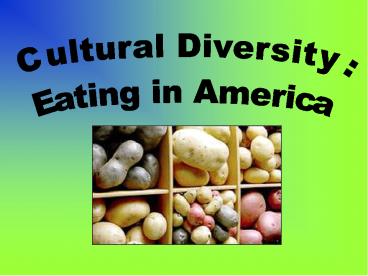Comparison of International Food Guide - PowerPoint PPT Presentation
1 / 6
Title:
Comparison of International Food Guide
Description:
... which are provided mainly by corn and corn products, beans, rice, and breads. ... Mexican diet contains an adequate amount of protein in the forms of beans, eggs, ... – PowerPoint PPT presentation
Number of Views:89
Avg rating:3.0/5.0
Title: Comparison of International Food Guide
1
2
(No Transcript)
3
Mexican-Americans
- In the U.S., Mexican-Americans comprise 60
percent of the Hispanic/Latino population. - Differences between Mexican, Puerto Rican, and
other Latin American countries includes 500 years
of separate history, as well as entirely
different native populations that were present
when the Spaniards arrived. - The Mexican diet of today is rich in a variety of
foods and dishes that represent a blend of
pre-Columbian, Spanish, French, and more
recently, American culture. - The typical Mexican diet is rich in complex
carbohydrates, which are provided mainly by corn
and corn products, beans, rice, and breads. - The typical Mexican diet contains an adequate
amount of protein in the forms of beans, eggs,
fish and shellfish, and a variety of meats,
including beef, pork, poultry, and goat. - Because of the extensive use of frying as a
cooking method, the Mexican diet is also high in
fat.
4
African-American
- The present day African-American population, like
many other ethnic groups, is several generations
removed from their original land. Thus many
practices and habits have been lost, dropped,
simulated, or modified. - The greatest influence on many African-American
families is the lifestyle of their parents or
grandparents who lived in the southern United
States. - The popular term for African-American cooking is
"soul food." Many of these foods are rich in
nutrients, as found in collard greens and other
leafy green and yellow vegetables, legumes,
beans, rice, and potatoes. - Other parts of the diet, however, are low in
fiber, calcium, potassium, and high in fat. With
high incidence of diabetes, hypertension, heart
disease, and obesity, some African-Americans have
paid a high price for this lifestyle.
5
The Amish
- The Amish are often referred to as the plain
people, known for their unadorned style of dress,
horse-drawn vehicles and family-centered
lifestyle. - Eating habits vary among the Amish depending on
where they live, the type of work they do, and
the mode of transportation they use.
Traditionally the Amish community has been farm
based with families growing or raising most of
their own food and traveling by horse and buggy.
This pattern is changing in urban areas, however,
because of the scarcity of land and hazards of
horse-and-buggy travel. Many Amish are leaving
their farms, and gardens are becoming smaller.
- Most Amish, especially those who still tend large
gardens and orchards, eat a variety of foods.
Because much of their work is physically
demanding, many are not concerned about reducing
the amount of fat in their diets. Those with
access to motorized transportation buy more
high-fat snack foods and eat out in restaurants
more often than those who travel by horse and
buggy.
6
Asian-American
Confucius said, "A man cannot be too serious
about his eating, for food is the force that
binds society together." This statement
summarizes the importance of food in the Asian
culture.
- Preparation is meticulous, and consumption is
ceremonious and deliberate. Two key elements draw
the diverse cultures of the Asian region
together 1) the composition of meals (emphasis
on vegetables and rice, relatively little meat)
and 2) cooking techniques. - Thai food is generally spicy, hot, and high in
sodium. Hot peppers are used daily. - The Japanese are very concerned about the visual
appeal of the food and the "separateness" of the
foods and tastes. Garlic and hot pepper are not
common ingredients. - Asian food preparation techniques include
stir-frying, barbecuing, deep-frying, boiling,
and steaming. All ingredients are carefully
prepared (chopped, sliced, etc.) prior to
starting the cooking process.































